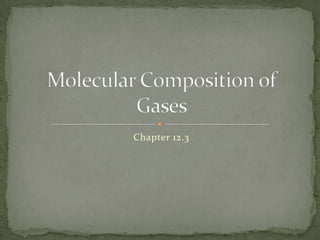
Applied Chapter 12.3 : Molecular Composition of Gases
- 1. Chapter 12.3 Molecular Composition of Gases
- 2. Solve problems using ideal gas law. Describe the relationships between gas behavior and chemical formulas, such as those expressed by Graham’s law of diffusion, law of combining gas volumes, and Dalton’s law of partial pressures. Objectives:
- 5. Charles’s law V/T = k
- 6. Avogadro’s law V/n = k
- 7. V = 1/P x T x n
- 8. V = R x 1/P x T x n
- 9. V = nRT or PV = nRT
- 11. R = PV = (1 atm)(22.4 L) = 0.0821 L*atm
- 17. The rates of effusion of gases at the same temperature and pressure are inversely proportional to the square roots of their molar masses.= vB2 MA vA MB = vB MA
- 18. Application of Graham’s Law Lighter gases (lower Molar mass or densities) diffuse faster than heavier gases. Also provides a method for determining molar masses. Rates of effusion of known and unknown gases can be compared to one another Rates of effusion of different gases
- 19. Problem 1 Compare the rates of effusion of hydrogen and oxygen at the same temperature and pressure. 32.00 g/mol Rate of effusion of H2 MO2 = 3.98 = = Rate of effusion of O2 2.02 g/mol MH2 ***Remember that the molar masses are inversely related ***Find the molar masses of each Hydrogen effuses 3.98 times faster than oxygen ***Expressed like this
- 20. Problem 2 A sample of hydrogen effuses through a porous container about 9 times faster than an unknown gas. Estimate the molar mass of the unknown gas. Rate of effusion of H2 Munknown = Rate of effusion of unknown MH2 2 Munknown 2 = 9 2.02 g/mol Munknown 81 = x 2.o2 g/mol 2.o2 g/mol x 2.02 g/mol Munknown = 160 g/mol
- 21. Dalton’s Law of Partial Pressures States that the total pressure of a mixture of gases is equal to the sum of the partial pressures of the component gases. Partial pressure: pressure of each gas in a mixture PT = p1 + p2 + p3 + …… PT= Total Pressure p1 + p2 + p3 = partial pressures
- 22. Dalton’s Law of Partial Pressures Gas collected by water displacement. Must include the pressure exerted by water vapor PT = p1 + p2 + p3 + …… So: Patm = pgas + pH2O
- 23. Dalton’s Law of Partial Pressures Sample Problem 5 Oxygen gas from the decomposition of potassium chlorate, KClO3, was collected by water displacement. The barometric pressure and the temperature during the experiment were 731.0 torr and 20.0oC, respectively. What was the partial pressure of the oxygen collected? Patm = pO2 + pH2O Patm = 731.0 torr PO2 = ? PH2O = 17.5 torr (from appendix in table A-8, pg. 899) pO2 = Patm - pH2O pO2 = 731.0 torr – 17.5 torr = 713.5 torr